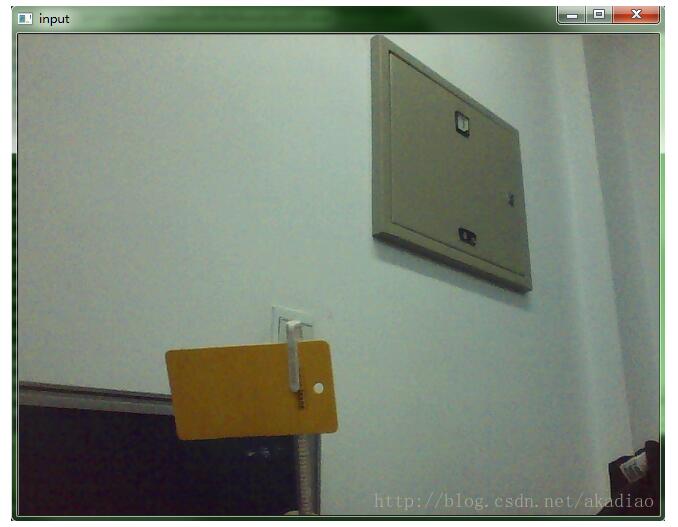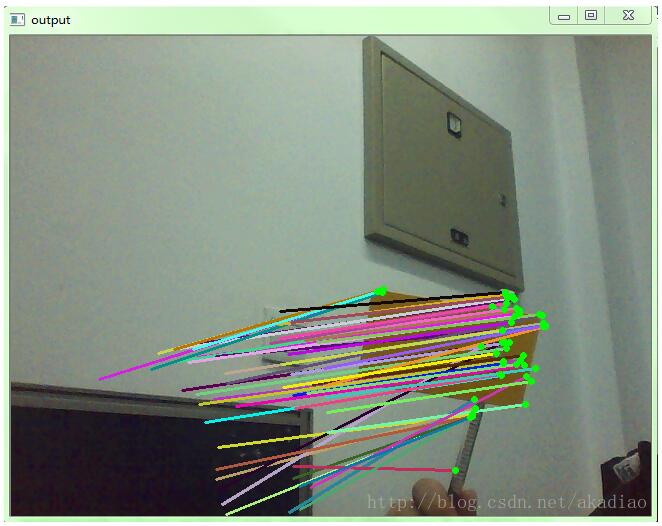光流金字塔 calcOpticalFlowPyrLK()函数参数说明: void calcOpticalFlowPyrLK(InputArray prevImg, //第一个8位输入图像或者通过 buildOpticalFlowPyramid()建立的金字塔InputArray nextImg,//第二个输入图像或者和
光流金字塔
calcOpticalFlowPyrLK()函数参数说明:
void calcOpticalFlowPyrLK( InputArray prevImg, //第一个8位输入图像或者通过 buildOpticalFlowPyramid()建立的金字塔 InputArray nextImg,//第二个输入图像或者和prevImg相同尺寸和类型的金字塔 InputArray prevPts, //二维点向量存储找到的光流;点坐标必须是单精度浮点数 InputOutputArray nextPts,//输出二维点向量(用单精度浮点坐标)包括第二幅图像中计算的输入特征的新点位置;当OPTFLOW_USE_INITIAL_FLOW 标志通过,向量必须有和输入一样的尺寸。 OutputArray status, //输出状态向量(无符号char);如果相应的流特征被发现,向量的每个元素被设置为1,否则,被置为0. OutputArray err,//输出错误向量;向量的每个元素被设为相应特征的一个错误,误差测量的类型可以在flags参数中设置;如果流不被发现然后错误未被定义(使用status(状态)参数找到此情形)。 Size winSize = Size(21,21), //在每个金字塔水平搜寻窗口的尺寸。 int maxLevel = 3,//最大金字塔层数; 如果设置为0,则不使用金字塔(单层),如果设置为1,则使用两个层次,依此类推; 如果将金字塔传递给输入,则算法将使用与金字塔一样多的级别,但不超过maxLevel。 TermCriteria criteria = TermCriteria(TermCriteria::COUNT+TermCriteria::EPS, 30, 0.01),//指定迭代搜索算法的终止标准(指定的最大迭代次数criteria.maxCount或搜索窗口移动小于criteria.epsilon) int flags = 0, //操作标志 double minEigThreshold = 1e-4 //计算光流方程的2×2标准矩阵的最小特征值除以窗口中的像素数量;如果这个值小于minEigThreshold,那么一个相应的特征被过滤出来,且它的光流不被处理,所以它允许去除坏点提升性能。 );
#include<opencv2/opencv.hpp>
using namespace cv;
//光流跟踪
Mat frame, gray, pr_frame, pr_gray;
std::vector<Point2f> inPoints;
std::vector<Point2f> fpts[2];
void trackFeature();
int main()
{
VideoCapture capture;
capture.open(0);
if(!capture.isOpened())
{
printf("can not open the camear......\n");
return -1;
}
namedWindow("input", CV_WINDOW_AUTOSIZE);
namedWindow("output", CV_WINDOW_AUTOSIZE);
while (capture.read(frame))
{
cvtColor(frame, gray, COLOR_BGR2GRAY);
if (fpts[0].size() < 40)
{
imshow("input", frame);
std::vector<Point2f> features;
//角点检测
goodFeaturesToTrack(gray, features, 300, 0.01, 10);
fpts[0].insert(fpts[0].end(), features.begin(), features.end());
inPoints.insert(inPoints.end(), features.begin(), features.end());
}
else
printf("object tracking......\n");
if (pr_gray.empty())
gray.copyTo(pr_gray);
trackFeature();
for (int i = 0; i < fpts[0].size(); i++)
circle(frame, fpts[0][i], 2, Scalar(0,255,0),2,8,0);
gray.copyTo(pr_gray);
frame.copyTo(pr_frame);
imshow("output", frame);
waitKey(1);
}
waitKey(0);
capture.release();
return 0;
}
void trackFeature()
{
std::vector<uchar> status;
std::vector<float> errors;
//计算稀疏特征集的光流
calcOpticalFlowPyrLK(pr_gray, gray, fpts[0], fpts[1], status, errors);
int k = 0;
for (int i = 0; i < fpts[1].size(); i++)
{
double dist = abs(fpts[0][i].x-fpts[1][i].x) + abs(fpts[0][i].y-fpts[1][i].y);
if (dist > 2 && status[i])
{
inPoints[k] = inPoints[i];
fpts[1][k++] = fpts[1][i];
}
}
inPoints.resize(k);
fpts[1].resize(k);
//绘制光流轨迹
RNG rng(0);
for (int i = 0; i < fpts[0].size(); i++)
{
Scalar color = Scalar(rng.uniform(0,255),rng.uniform(0,255),rng.uniform(0,255));
line(frame, inPoints[i], fpts[1][i], color,2);
circle(frame, fpts[1][i], 2, Scalar(0,255,255),2);
}
std::swap(fpts[1], fpts[0]);
}


以上这篇opencv3/C++实现光流点追踪就是小编分享给大家的全部内容了,希望能给大家一个参考,也希望大家多多支持自由互联。
